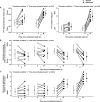Effects of circadian misalignment on cognition in chronic shift workers
- PMID: 30679522
- PMCID: PMC6346005
- DOI: 10.1038/s41598-018-36762-w
Effects of circadian misalignment on cognition in chronic shift workers
Abstract
Shift work is associated with increased human operational errors, presumably due to the circadian timing system that inhibits optimal cognitive function during the night. Circadian misalignment, which is the misalignment between the circadian pacemaker and behavioral/environmental cycles, impairs cognitive performance in non-shift workers. However, it remains uncertain whether the adverse cognitive consequences of circadian misalignment are also observed in chronic shift workers. Thus, we investigated the effects of circadian misalignment on cognitive performance in chronic shift workers. Using a randomized, cross-over design that simulated day shift work (circadian alignment) and night shift work (circadian misalignment), we show that circadian misalignment increases cognitive vulnerability on sustained attention, information processing and visual-motor performance, particularly after more than 10 hours of scheduled wakefulness. Furthermore, their increased levels of subjective sleepiness and their decreased sleep efficiency were significantly associated with impaired sustained attention and visual-motor performance. Our data suggest that circadian misalignment dramatically deteriorates cognitive performance in chronic shift workers under circadian misalignment. This increased cognitive vulnerability may have important safety consequences, given the increasing number of nighttime jobs that crucially rely on the availability of cognitive resources.
Conflict of interest statement
C.J.M. reports receiving a salary from Grünenthal Ltd, UK; this relationship is not related to the current article. F.A.J.L.S. received speaker fees from Bayer Healthcare, Sentara Healthcare, Philips, Kellogg Company, Vanda Pharmaceuticals, and Pfizer Pharmaceuticals; this relationship is not related to the current article.
Figures





References
-
- Labor. USDo. National health interview survey (NHIS) (2011).
Publication types
MeSH terms
Grants and funding
LinkOut - more resources
Full Text Sources

